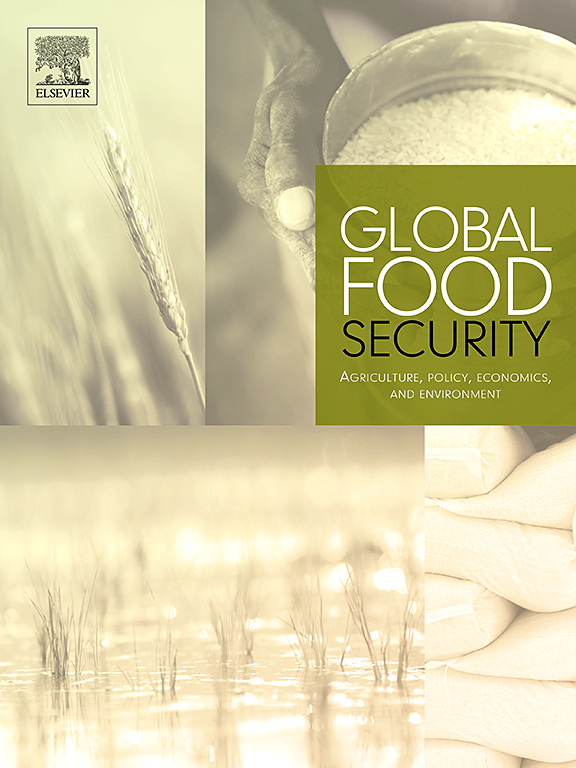Narrowing the ecological yield gap to sustain crop yields with less inputs
IF 9.6
1区 经济学
Q1 FOOD SCIENCE & TECHNOLOGY
Global Food Security-Agriculture Policy Economics and Environment
Pub Date : 2025-04-19
DOI:10.1016/j.gfs.2025.100857
引用次数: 0
Abstract
Sustainable production of sufficient and healthy food requires efficient use of agricultural inputs. In many regions of the world with intensive agriculture and relatively small yield gaps, this calls for a reduction of external inputs (fertilizers and pesticides) while maintaining yields. Ecological intensification, defined as the use of practices that enhance on-farm ecosystem services to reduce external input requirements, has been proposed as a strategy to help achieve this. However, the effects of ecological intensification are context- and input-dependent, creating uncertainty on its effectiveness and feasibility. Here, we introduce the concept of an ‘ecological yield gap’ to provide a common analytical framework to strengthen collaboration between agronomists and ecologists in assessing the contribution of ecosystem services within the wider array of inputs, management practices, technologies, and biophysical limits that determine on-farm crop yields. We define the ecological yield gap as the yield increase that could be achieved in a given context (climate x soil x cropping system), and at a given input level, by increasing the delivery of ecosystem services via ecological intensification practices that support crop growth and substitute external inputs. We provide empirical examples of such practices, including crop diversification, service crops, and organic amendments that can increase the use efficiency of mineral fertilizers and suppress pests, weeds and diseases. The potential of these practices to narrow the ecological yield gap and their feasibility at farm level depend on how the ecosystem services they provide interact with other aspects of the farming system and requires analysis at farm level. This perspective paper aims to facilitate a shared research agenda among agronomists and ecologists to develop complementarity between ecosystem services and inputs at field and farm levels.
缩小生态产量差距,以较少投入维持作物产量
可持续生产充足和健康的食物需要有效利用农业投入。在世界上许多集约化农业和产量差距相对较小的地区,这要求在保持产量的同时减少外部投入(化肥和农药)。生态集约化被定义为使用增强农场生态系统服务以减少外部投入需求的做法,已被提议作为帮助实现这一目标的战略。然而,生态集约化的影响依赖于环境和投入,对其有效性和可行性产生了不确定性。在这里,我们引入了“生态产量缺口”的概念,以提供一个共同的分析框架,以加强农学家和生态学家之间的合作,评估生态系统服务在决定农田作物产量的更广泛的投入、管理实践、技术和生物物理限制中的贡献。我们将生态产量缺口定义为在给定的环境(气候x土壤x种植制度)下,在给定的投入水平上,通过支持作物生长和替代外部投入的生态集约化实践增加生态系统服务的提供,可以实现的产量增加。我们提供了此类实践的经验例子,包括作物多样化、服务作物和有机改良,这些改良可以提高矿物肥料的利用效率,并抑制害虫、杂草和疾病。这些做法缩小生态产量差距的潜力及其在农场层面的可行性取决于它们提供的生态系统服务如何与农业系统的其他方面相互作用,并需要在农场层面进行分析。这篇前瞻性的论文旨在促进农学家和生态学家之间的共同研究议程,以发展生态系统服务与田间和农场层面投入之间的互补性。
本文章由计算机程序翻译,如有差异,请以英文原文为准。
求助全文
约1分钟内获得全文
求助全文
来源期刊

Global Food Security-Agriculture Policy Economics and Environment
FOOD SCIENCE & TECHNOLOGY-
CiteScore
20.90
自引率
3.40%
发文量
69
期刊介绍:
Global Food Security plays a vital role in addressing food security challenges from local to global levels. To secure food systems, it emphasizes multifaceted actions considering technological, biophysical, institutional, economic, social, and political factors. The goal is to foster food systems that meet nutritional needs, preserve the environment, support livelihoods, tackle climate change, and diminish inequalities. This journal serves as a platform for researchers, policymakers, and practitioners to access and engage with recent, diverse research and perspectives on achieving sustainable food security globally. It aspires to be an internationally recognized resource presenting cutting-edge insights in an accessible manner to a broad audience.
 求助内容:
求助内容: 应助结果提醒方式:
应助结果提醒方式:


